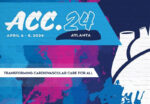Transcatheter aortic valve intervention (TAVI) has been shown beneficial over the years. However, a significant subgroup of patients with small aortic annulus, which make approximately one third of cases and have a higher incidence in women, face additional challenge, such as higher incidence of mismatch, reduced exercise capacity and shorter durability. Self-expanding and balloon expandable...
ACC 2024 | IVUS-DCB
Drug-coated balloons (DCB) have proven to be effective in the treatment of femoropopliteal pathology, although they entail complications such as recoil, residual stenosis, and dissection. Their outcomes could be improved through proper and enhanced vessel preparation, both before and after the procedure. Intravascular ultrasound (IVUS) offers the advantage of characterizing plaque and assessing vessel diameter....
ACC 2024 | REDUCE AMI: Beta-Blockers after Myocardial Infarction and Preserved Ejection Fraction
Most clinical trials have shown benefits of beta blockers after acute myocardial infraction, including patients with extensive AMI, and these were carried out in the era before AMI was diagnosed with biomarkers and prior to treatment with coronary angioplasty, use of antithrombotic agents and high intensity statins, and angiotensin-aldosterone system inhibitors. The aim of this...
ACC 2024 | DEDICATE Trial: Transcatheter or Surgical Treatment of Aortic Valve Stenosis
In recent years, TAVR has been increasingly used; however, when it comes to younger, lower risk patients, its use is still challenged. In this context, there is limited information and we lack randomized studies on “real world” cohorts. The DEDICATE randomized 1.414 patients over 65 with severe symptomatic aortic stenosis. 701 of these patients received...
ACC 2024 | RELIEVE-HF
Heart failure is characterized by increased left atrial filling pressure and venous congestion which intensify with exercise and volume burden, and makes conventional medical management hard. In this context, interatrial shunting might offer a self-regulating mechanism, as shown by the Ventura IAS study. The aim of this study was to assess the safety and efficacy...
Lithotripsy in the “Real World”: REPLICA EPIC-18 Study
Severe persistent calcification of the coronary arteries has been associated with different factors, such as advanced age, hypertension, dyslipidemia, smoking, and kidney failure, among others, and continues to be one of the challenges to stent implantation because of it impact on device advancing, drug release and adequate positioning. Intravascular lithotripsy (IVL) is a technique that...
Virtual Flow Reserve (VFR): Virtual Physiological Test with OCT
Assessing intermediate coronary lesions with intracoronary physiology tests such as fractional flow reserve (FFR) or other non-hyperemic indices is considered the standard of care by both American and European societies. Likewise, intravascular imaging techniques (IVI), be it IVUS or optical coherence tomography (OCT), are of great use in assessing and guiding complex coronary lesions and...
Transcatheter Myotomy for the Treatment of the Dynamic Obstruction of the Left Ventricular Outflow Tract
Septal reduction therapies are used to mitigate the symptoms caused by dynamic left ventricular outflow tract (LVOT) obstruction and the associated mitral regurgitation (MR) that can surge in hypertrophic cardiomyopathy (HCM). Alternative therapies to treat LVOT obstruction include surgical procedures, i.e. surgical myotomy or myomectomy, or alcohol and radiofrequency septal ablation (intracardiac, transthoracic and endocardial,...
Proximal Optimization Technique in Unprotected LMCA
Proximal optimization technique (POT) has been recommended as a standard strategy in bifurcation lesions because it facilitates proper stent implantation and apposition in the proximal main vessel, according to the European Bifurcation Club. Percutaneous coronary intervention (PCI) of the unprotected left main coronary artery (LMCA) has specific characteristics, and the long-term impact of this strategy...
Should We Use Ultrasound Routinely to Guide Transfemoral Access?
Currently, transfemoral access (TFA) is used in large-caliber procedures and when transradial access fails. The introduction of ultrasound (US) to guide access has emerged as a technique that allows for precise channeling, avoiding accesses above or below the inguinal ligament. However, evidence regarding the use of this tool has shown diverse results. Two surveys conducted...






